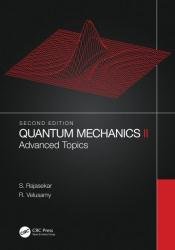Quantum Mechanics II: Advanced Topics, 2nd Edition
- Добавил: literator
- Дата: 10-10-2022, 04:57
- Комментариев: 0
 Название: Quantum Mechanics II: Advanced Topics, 2nd Edition
Название: Quantum Mechanics II: Advanced Topics, 2nd EditionАвтор: S. Rajasekar, R. Velusamy
Издательство: CRC Press
Год: 2023
Страниц: 433
Язык: английский
Формат: pdf (true)
Размер: 17.4 MB
Quantum Mechanics II: Advanced Topics offers a comprehensive exploration of the state-of-the-art in various advanced topics of current research interest. A follow-up to the authors’ introductory book Quantum Mechanics I: The Fundamentals , this book expounds basic principles, theoretical treatment, case studies, worked-out examples and applications of advanced topics including quantum technologies.
A thoroughly revised and updated this unique volume presents an in-depth and up-to-date progress on the growing topics including latest achievements on quantum technology. In the second edition six new chapters are included and the other ten chapters are extensively revised.
The volume II consists of 16 chapters. Chapter 1 describes the basic ideas of both classical and quantum field theories. Quantization of nonrelativistic equation, electromagnetic field, Klein–Gordon equation and Dirac field is given. The formulation of quantum mechanics in terms of path integrals is presented in chapter 2. Application of it to free particle and undamped and damped linear harmonic oscillators are considered. In chapter 3 some illustrations and interpretation of supersymmetric potentials and partners are presented. A simple general procedure to construct all the supersymmetric partners of a given quantum mechanical systems with bound states is described. The method is then applied to a few interesting system. A method to generate complex potentials with real eigenvalues is presented. The next chapter is concerned with coherent and squeezed states. Construction of these states and their characteristic properties are enumerated. Chapter 5 is devoted to Berry’s phase, Aharonov–Bohm and Sagnac effects. Their origin, properties, effects and experimental demonstration are presented. The features of Wigner distribution function are elucidated in chapter 6.
In composite quantum systems, entanglement is a kind of correlation between subsystems with no classical counterpart. The definition, detection, classification, quantification and the application of quantum entanglement are covered in chapter 7. The next chapter discusses the concept of quantum decoherence, its models, experimental studies on it and its significance in the interpretation of quantum mechanics. There is a growing interest on quantum computing. Basic aspects of quantum computing are presented in chapter 9. Deutsch–Jozsa algorithm of finding whether a function is constant or not, Grover’s search algorithm and Shor’s efficient quantum algorithm for integer factorization and evaluation of discrete logarithms are described. Chapter 10 deals with quantum cryptography. Basic principles of classical cryptography and quantum cryptography and features of a few quantum cryptographic systems are discussed...
Features:
Covers classical and quantum field theories, path integral formalism and supersymmetric quantum mechanics.
Highlights coherent and squeezed states, Berry’s phase, Aharonov—Bohm effect and Wigner function.
Explores salient features of quantum entanglement and quantum cryptography.
Presents basic concepts of quantum computers and the features of no-cloning theorem and quantum cloning machines.
Describes the theory and techniques of quantum tomography, quantum simulation and quantum error correction.
Introduces other novel topics including quantum versions of theory of gravity, cosmology, Zeno effect, teleportation, games, chaos and steering.
Outlines the quantum technologies of ghost imaging, detection of weak amplitudes and displacements, lithography, metrology, teleportation of optical images, sensors, batteries and internet.
Contains several worked-out problems and exercises in each chapter.
Quantum Mechanics II: Advanced Topics addresses various currently emerging exciting topics of quantum mechanics. It emphasizes the fundamentals behind the latest cutting-edge developments to help explain the motivation for deeper exploration. The book is a valuable resource for graduate students in physics and engineering wishing to pursue research in quantum mechanics.
Скачать Quantum Mechanics II: Advanced Topics, 2nd Edition
Внимание
Уважаемый посетитель, Вы зашли на сайт как незарегистрированный пользователь.
Мы рекомендуем Вам зарегистрироваться либо войти на сайт под своим именем.
Уважаемый посетитель, Вы зашли на сайт как незарегистрированный пользователь.
Мы рекомендуем Вам зарегистрироваться либо войти на сайт под своим именем.
Информация
Посетители, находящиеся в группе Гости, не могут оставлять комментарии к данной публикации.
Посетители, находящиеся в группе Гости, не могут оставлять комментарии к данной публикации.
